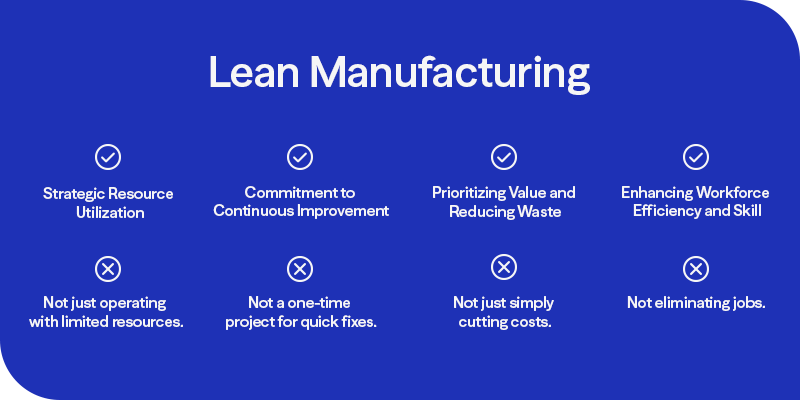Key Takeaways
- Lean manufacturing revolutionizes the production process by streamlining operations, reducing waste, and delivering high-impact value to customers.
- There is not a one-size-fits-all lean solution. You must carefully evaluate current processes and desired outcomes.
- The success of lean manufacturing relies on top-down buy-in as well as cultural acceptance.
For today’s manufacturing companies, the mandate is clear: deliver more value with less. Operating with agility is crucial to navigating labor shortages, supply chain volatility, or rising customer expectations.
Enter lean manufacturing — a methodology that revolutionizes the production process by streamlining operations, reducing waste, and delivering high-impact value to customers.
When applied effectively, lean practices can:
- Eliminate unnecessary processes, materials, and labor, lowering operational expenses.
- Minimize changeover times and remove bottlenecks.
- Improve product quality and reduce defects.
- Enhance cross-functional collaboration and visibility.
- Drive continuous improvement across all levels of the organization.
By eliminating non-essential activities and optimizing resource use, lean principles empower manufacturing teams to work smarter, not harder.

Key Lean Manufacturing Principles
Lean manufacturing is built on five foundational principles that guide organizations toward operational success. Here's how to put those principles into practice:
Value
Define what “value” means to your customer. Every process, material, and activity should contribute directly to delivering that value; anything that doesn’t is considered waste.
Value Stream
Map the value stream, i.e., the flow of materials, information, and processes required to deliver the product or service to the customer. This distinguishes between value-added and non-value-added activities.
Flow
Confirm that the production process flows smoothly without interruptions. This may involve reorganizing workspaces, balancing workloads, or redesigning processes to prevent delays and bottlenecks.
Pull
Produce what is needed based on customer demands, rather than forecasts. Instead of pushing products through the manufacturing process and hoping they will sell, the pull system encourages production driven by actual orders.
Perfection
Foster a culture of continuous improvement where employees are encouraged to explore ways to minimize inefficiencies.
Lean Manufacturing in Action: A Real-World Transformation
The Challenge:
A logistics provider was grappling with unstandardized processes across its multiple facilities, leading to inconsistent performance and extended cycle times.
The Solution:
The company began a lean transformation rooted in the 5S methodology:
- Sort: Removed unnecessary items and clutter from workstations.
- Set in Order: Organized essential tools and materials for easy access.
- Shine: Cleaned and maintained workstations and equipment.
- Standardize: Developed standardized procedures and layouts for consistency across facilities.
- Sustain: Established best practices to encourage lasting success.
The Results:
In just 13 weeks, the company achieved:
- Labor Savings: Each facility reported over $1 million in labor savings due to more efficient processes and reduced time spent searching for tools and materials.
- Capacity Gains: Lean practices increased revenue per square foot, demonstrating improved productivity and space utilization.
- Operational Consistency: With standardized processes in place, the company is now able to focus more energy on larger, higher-impact initiatives.
Common Challenges and How to Overcome Them
Successful implementation of lean principles requires organization-wide commitment and a clear understanding of the cultural and operational shifts that lean demands.
Cultural Resistance
Lean manufacturing is often misunderstood as a mere cost-cutting tactic, rather than a value add. Employees may not see the immediate need for change, especially if the current processes have been functioning "well enough."
Overcome this by clearly communicating the purpose of the change and involving employees early and often to build trust and buy-in.
Leadership Support
The success of lean manufacturing depends on alignment between top-down leadership and bottom-up cultural acceptance. As a leader, you must endorse the initiative, actively participate, and provide the necessary resources.
Tailored Implementation
Lean is not a one-size-fits-all solution. Lean principles must be tailored to the specific needs and circumstances of each company. For example, a large-scale manufacturer with complex supply chains will require a different approach than a small assembly operation.
The decision to adopt lean manufacturing should be based on a thorough analysis of current operations, areas of improvement, and resources required.
Next Steps for Strategic Manufacturers
Lean manufacturing reduces waste, improves efficiency, and enhances overall quality. However, its success depends on understanding whether lean principles align with your specific business needs and preparing for the changes required.
Eide Bailly’s experienced advisors can help determine if lean is right for your organization and guide you through every step of the implementation process. Whether you’re looking to streamline your operations or enhance your competitive edge, we’re here to help.
Make a habit of sustained success.

Manufacturing, Distribution, and Logistics
Rely on the trusted expertise of manufacturing advisors to help you build and execute your strategic vision.
Who We Are
Eide Bailly is a CPA firm bringing practical expertise in tax, audit, and advisory to help you perform, protect, and prosper with confidence.



